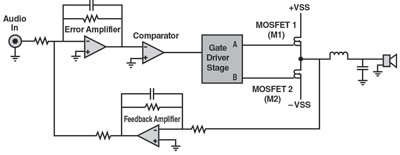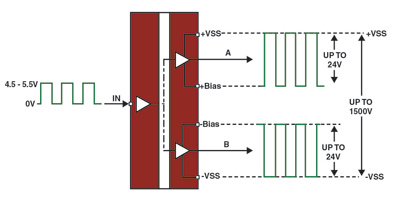Class D amps in today’s high-power audio apps
Design considerations using class D audio amplifiers
BY ASHISH GOKHALE
Marketing Manager, Isolation Products
Silicon Labs, www.silabs.com
The continuing demand for higher audio fidelity, lower system cost, and reduced power consumption is accelerating the adoption of Class D amplifiers in today’s high-power audio applications. Although traditional analog implementations, such as Class AB topology, are more complex and less efficient than Class D systems, they have dominated the high end of the audio market on the merits of their high-fidelity performance. The good news is that Class D systems are quickly narrowing this performance gap with simpler, more efficient designs that offer fidelity capable of surpassing that of analog amplifiers.

Fig. 1: Class D amplifier with gate driver.
A Class D audio system converts audio signals at its input to a digital PWM signal, adds power amplification in the digital domain, and then converts the digital signal back to analog at its output. As shown in Fig. 1 , the incoming audio signal is applied to a pulse-width modulator (PWM), which consists of an operational amplifier and a comparator. This modulator digitizes the audio input by varying the modulator duty cycle in direct proportion to the instantaneous value of the audio input signal.
This PWM signal is level shifted and applied to a gate driver that switches a two-state power circuit consisting of MOSFETs (M1 and M2). The resulting amplified signal then passes through an output filter, which removes the PWM carrier frequency, leaving only the amplified analog audio signal that ultimately drives the speakers. Audio output fidelity is further enhanced by the outer feedback loop from the filter input to the error amplifier input thereby reducing distortion and noise.
Class D amplifier designPower efficiencyHistorically, analog power amplifiers have relied on linear amplification circuits that are prone to high-power losses. By comparison, Class D amplifier power efficiencies can be 90% or higher, depending on the design. This high efficiency benefit is intrinsic in Class D technology where binary switches, (usually power MOSFETs) provide the amplification mechanism. These switches are either fully on or off, and very little time is spent transitioning between those two states. This discrete switching action, and low MOSFET on-resistance, minimize I2 R losses and increase efficiency. In practice however, the switch transition time (dead time) must be long enough to avoid efficiency-killing shoot-through currents from both switches being on simultaneously. High fidelityAudio fidelity can be defined as the faithfulness with which sound is reproduced. For audio systems, fidelity is a proxy for the all-enveloping term “sound quality.” While various specifications are used to quantify fidelity, some of these measures are especially challenging for designers. Two of the most challenging specifications are total harmonic distortion (THD) and noise (N), collectively referred to as THD + N.
THD is a measure of accuracy of an audio system. Inaccuracies in signal reproduction create additional signal components at harmonic multiples of the input frequencies, which obviously distract from the purity of the output signal. THD is the ratio of the unwanted energy of all harmonic frequencies to the energy of the fundamental frequencies of the input, typically measured at half of full power for a given system. While THD performance of less than 0.1% is adequate for most non-audiophile audio applications, discerning listeners usually prefer THD levels as low as 0.05% or even lower.
Output noise level is a measure of the noise floor level of the amplifier outputs with no signal input. For most speakers, a noise floor of 100-500 µV is inaudible from most normal listening distances, while a noise floor as high as 1 mV will prove to be quite annoying. THD + N is a very good indicator of the audio fidelity of a given amplifier.
Class D driver IC: features and benefitsProgrammable dead-timeClass D amplifier dead-time (i.e., the period when both switches are off) directly impacts both efficiency and THD. An overly short dead-time causes shoot-through currents that decrease efficiency. However, a dead-time that is too long results in increased THD, which negatively affects audio fidelity.
The dead-time period must be set precisely to hit the “sweet spot” that optimizes both power efficiency and THD. The typical high-voltage audio drivers available today have coarse and overlapping dead-time settings (that is, 1 of n delay values). As a result, most designers choose to implement the dead-time period using discrete components, which can be expensive and time consuming. A more elegant and cost-effective solution would be to integrate a gate driver with a highly precise dead-time generator.
Level shiftingImplementing a two-state Class D amplifier can be difficult due to input level shifting requirements. In high-power Class D amplifiers, it is desirable to have high-voltage supply rails (± VSS) for the power MOSFET stage. For practical Class D amplifier designs, a voltage of ±100 Vdc can deliver an astounding 600 watts of audio power into 8 Ω.
Most high-voltage IC (HVIC) Class D drivers lack the capability to provide level shifting from the low-voltage modulation section to the high-voltage power section. Drivers that provide level shifting have other deficiencies, making them less than ideal for Class D operation. (For example, the driver output ground terminal is referenced to a negative voltage rail, requiring the input drive signal to be level shifted to the negative supply). This functionality is added through discrete components, which can be costly and difficult to design and take up an inordinate amount of space. Level-shifting solutions that provide an interface to high-voltage bipolar supply rails would be a significant advantage in Class D designs (see Fig. 2 .) Most driver solutions typically do not offer input-to-output isolation or isolation between the drivers. Thus, it becomes necessary to provide a level shifting mechanism with extra components.

Fig. 2: Level shifting can provide an interface between a low-voltage digital modulator and a high-voltage bipolar output supply.
Reliability and noise immunityTypical gate driver ICs available today have a tendency to latch-up at high voltage transients of 20 V/ns or greater and typically do not have any immunity to high slew rate noise transients coupling back from the power stage to the precision digital input side. This is a major disadvantage when trying to keep the noise floor as low as possible for the best audio fidelity. High-frequency operationOne of the best attributes a Class D gate driver can have is its ability to operate at high switching frequencies with minimum of propagation delay. These attributes allow the total loop delay in the feedback path to be exceptionally low for the best possible noise performance. Higher frequency operation also improves the “loop gain,” which typically improves the distortion performance of the amplifier. Most HVIC drivers available today only support modulation frequencies of up to 1 MHz.IntegrationIn today’s competitive global markets, a Class D audio solution that integrates all of these features would provide a much needed advantage to high-power amplifier designers, enabling them to get their products to market early by minimizing costly design time, component count, insertion costs and the lower reliability associated with higher parts count. ■
Advertisement
Learn more about Silicon Labs





